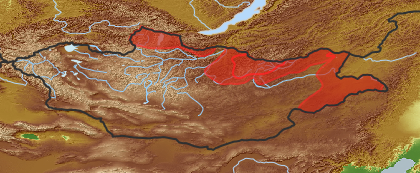| Class: | angiosperms |
| Order: | Fagales |
| Family: | Betulaceae |
| Genus: | Duschekia |
| Scientific name: | Duschekia fruticosa (Rupr.) Pouzar |
| Name acc. to: | Gubanov 1996 |
| Herbar: | list records   |
| Synonym: | Alnus fruticosa Rupr. (acc. to Grubov 1982) |
| Synonym: | Alnaster fruiticosus (Rupr.) Ledeb (acc. to IOPI: Vascular Plants of Russia and Adjacent Countries as of 26.10.96) |
| Description: | Leaves ovate, finely and acutely dentate glabrous, 4-7 cm long. Pistillate aments on long pedicels in racemes by 3-5. |
| Comments: | See also: http://www.manfred-vesper.de/datei.php?did=208 [DE] and http://www.manfred-vesper.de/datei.php?did=269 [MON] |
| open map in a new window |  |
| Habitat: | Damp and bogged mountain slopes, mixed forests and groves, screes, forest fringes, ravines and river banks in forest belt (Grubov 2001). |
| Habit (i)general appearance of a plant | |
| Growth form: (i)Herb, shrub, tree or climber. | shrub, subshrub or semishrub (i)Shrub, multi-stemmed, mostly (0.2) 0.5 - 5 m high, shoots woody up to the tip
example: Caragana leucophloea 
|
| Parasite status: (i)Is the plant a half- or full parasite? | no parasite/saprophyte (i)Plant fully autonomous, leaves with chlorophyll
example: Most plants, Ranunculus  inherited by family Betulaceae: no parasite/saprophyte inherited by family Betulaceae: no parasite/saprophyte
|
| Water or terrestrial plant: (i)Where do the plants grow? | terrestrial (i)Plant grows on dry land
example: Orostachys spinosa  inherited by family Betulaceae: terrestrial inherited by family Betulaceae: terrestrial
|
| Leaf (i)expanded, usually photosynthetic organ of a plant (including phylloclades) | |
| Leaf development: (i)Structure and development of leaves. | with green leaves (i)Plant with green leaves  inherited by family Betulaceae: with green leaves inherited by family Betulaceae: with green leaves
|
| Leaf arrangement: (i)Arrangement of leaves at the stem. | alternate (i)One leaf per node; distiche: arranged in two vertical rows, equitant
example: Phragmites    inherited by family Betulaceae: alternate inherited by family Betulaceae: alternate
|
| Simple or divided leaves: (i)Are the leaves simple or completely divided in several parts? Blade of the leaf entire or (more or less) deeply dissected. Attention: There are various appearances of the leaf margin (from entire to toothed and lobed). Here, we ignore this and ask only for dissections that separate the leaf for more than one third of its length or width, whatever is smaller. Sometimes, it is difficult to tell apart compound leaves from a shoot system with simple leaves: look for stipulae and/or axillary buds at the ground of the leaves: if only some possess these structures, the others are most likely leaflets of a compound leaf. | simple (i)Non-divided leaf, but margin may be incised nearly to the ground   inherited by family Betulaceae: simple inherited by family Betulaceae: simple
|
| Petiole: (i)Leaf divided into stalk (petiole) and blade. | with (i)Leaves with petiole (stalk)   inherited by family Betulaceae: with inherited by family Betulaceae: with
|
| Stipule: (i)Leaflets at the base of the petiole, these are smaller and of different shape. | pair (i)A pair of free stipulae
example: Lathyrus, Trifolium   inherited by family Betulaceae: pair inherited by family Betulaceae: pair
|
| Leaf colour upper side: (i)Shades of green on the leaf, upper side. | green (i)Clear green
example: Tribulus terrestris  inherited by family Betulaceae: green inherited by family Betulaceae: green
|
| Leaf colour lower side: (i)Shades of green on the leaf, lower side. | green (i)Clear green, in most species
example: Angelica decurrens  inherited by family Betulaceae: green inherited by family Betulaceae: green
|
| Leaf veination: (i)Arrangement of the main veins of a leaf. | pinnate (i)One main vein, several side veins, sometimes inconspicuous
example: Cicerbita     inherited by family Betulaceae: pinnate inherited by family Betulaceae: pinnate
|
| Flower (i)reproductive portion of the plant, consisting of sepals, petals, stamens, and pistils | |
| Flower appearance and pollination: (i)General appearance of the flower. | not attractive, wind-pollinated or some water plants (i)Small, colourless or green flowers
example: Betula, grasslike plants: Carex, Setaria, Juncus  inherited by family Betulaceae: not attractive, wind-pollinated or some water plants inherited by family Betulaceae: not attractive, wind-pollinated or some water plants
|
| Flower colour: (i)Attention: assess colour of the most colourful parts of the flower, but not of the stamens; be aware of single plants with a mutation (mostly white) on flower colour. | colourless (i)Dry membranous  inherited by family Betulaceae: colourless inherited by family Betulaceae: colourless
|
| Perianth arrangement: (i)Attention: in some plants, flowers may be dimorphic in different ways (dioecious or gynodioecious). If flowers vary, record the characters of the most showy flowers. | absent or strongly reduced (i)No perianth leaves ensheathing stamen and/or carpels
example: Callitriche   inherited by family Betulaceae: absent or strongly reduced inherited by family Betulaceae: absent or strongly reduced
|
| Diameter of flower: (i)Diameter of flower or flower head. | to 5 mm (i)
example: Aruncus  inherited by family Betulaceae: inherited by family Betulaceae:
|
| Spur: (i)A hollow, slender, sac-like appendage of the perianth leaves, storing nectar. | no spur (i)Flower without appendage
example: Peganum  inherited by family Betulaceae: no spur inherited by family Betulaceae: no spur
|
| Stamen number: (i)Attention: We ask for the reproductive organs of the flower dispersing pollen. Count only fully fertile stamens, not staminodia (e.g. Parnassia). | 4 (i)Extremely rare, may be absent
example: Plantago  inherited by genus Duschekia: 4 inherited by genus Duschekia: 4
|
| Stamen fusion: (i)To which degree are the stamens fused? Attention: Whereas the pollen sacs itself are often free., their stalks (filaments) may be fused. Here, we count them as fused if they are together over at least one thirth of their length. | free (i)Stamens with separate bases
example: Malus  inherited by family Betulaceae: free inherited by family Betulaceae: free
|
| Carpel number: (i)Number of carpels (carpel: forming a simple pistil or part of a compound pistil, modified leaf). | 2  inherited by family Betulaceae: 2 inherited by family Betulaceae: 2
|
| Carpel fusion: (i)To which degree are the carpels (modified leaf forming simple pistil or part of a compound pistil) fused. | fused (i)Carpels united into an ovary, only styles are free
example: Malus, Berberis  inherited by family Betulaceae: fused inherited by family Betulaceae: fused
|
| Ovary position: (i)For entirely or partly fused carpels, describe their position in relation to the insertion point of perianth leaves (best done by doing a longitudinal section of a flower). | inferior (i)Ovary below the point where perianth leaves are inserted, always fused to an ovary
example: Vaccinum    inherited by family Betulaceae: inferior inherited by family Betulaceae: inferior
|
| Sex: (i)Distribution of male and female organs among flowers, only most commonly cases. | unisexual (i)
example: Rhodiola  inherited by family Betulaceae: unisexual inherited by family Betulaceae: unisexual
monoecious (i)Male and female flowers at the same plant
example: Xanthium, Larix, Atriplex  inherited by family Betulaceae: monoecious inherited by family Betulaceae: monoecious
|
| Inflorescence (i)flowering part of a plant, describes the arrangement of the flowers on the flowering axis | |
| Inflorescence: (i)Structure of the inflorescence. | Flowers in inflorescence (i)No solitary flowers  inherited by family Betulaceae: Flowers in inflorescence inherited by family Betulaceae: Flowers in inflorescence
|
| Appearance: (i)Outer look of the inflorescence. | axillary (i)Usually several inflorescences in axillary shoots or single flowers in leaf axils, main shoot remains mostly leafy
example: Tragopogon, Aconogonon  inherited by family Betulaceae: axillary inherited by family Betulaceae: axillary
|
| Inflorescence type: (i)Types of inflorescence. Attention: We here ask for the botanical nomenclature of inflorescences, which is sufficiently complicated. Tick only, if you are certain, or tick all inflorescence types that appear similar of these of the plant in question. | catkin (i)Mostly unisexual flowers, in pendulous spikes ore racemes, often falling as a whole after fruiting
example: Betula (male pendulous, female upward), Corylus (only male inflorescences, pendulous), Salix (strict upward), Populus (pendulous)   inherited by family Betulaceae: catkin inherited by family Betulaceae: catkin
|
| Fruit (i)the seed bearing organ, with or without adnate parts; a ripened ovary and any other structures which are attached and ripen with it. Aggregate fruits are handled like simple fruits for determination. | |
| Consistency: (i)Fleshy fruits or dry fruits, see dispersal adaptations for further classification. | dry (i)With a dry outer shell, no fleshy parts, but seed (embryo) could be edible  inherited by family Betulaceae: dry inherited by family Betulaceae: dry
|
| Type of fruit: (i)Common fruit types (including pseudocarp). | Indehiscent fruits  inherited by family Betulaceae: Indehiscent fruits inherited by family Betulaceae: Indehiscent fruits
Solitary fruits (i)     inherited by family Betulaceae: Solitary fruits inherited by family Betulaceae: Solitary fruits
nut or nutlet (i)Dry fruit with a single, hard stone inside (and usually a large often edible embryo)   inherited by family Betulaceae: nut or nutlet inherited by family Betulaceae: nut or nutlet
|
| Opening of fruit: (i)Mode of dehiscence at maturity to release seeds. | not opening / indehiscent (i)Fruits remain closed at maturity and disperse with seeds inside
example: Corylus (nut), Vaccinium (berry)  inherited by family Betulaceae: not opening / indehiscent inherited by family Betulaceae: not opening / indehiscent
|
| Size of fruit: (i)Size of the fruit including appendage. | to 5 mm (i)
example: Halerpestes: many folicles forming dry nutlets  inherited by family Betulaceae: inherited by family Betulaceae:
|
| Dispersal: (i)Appearance of fruit or seed (if single) and adaptations to dispersal. | Flying (wind dispersed) (i)Fruits or seeds with appendages to fly
example: Taraxacum, Atraphaxis, Pulsatilla  inherited by family Betulaceae: Flying (wind dispersed) inherited by family Betulaceae: Flying (wind dispersed)
|
| Seed number: (i)Estimate the number of seeds per fruit, if recognizable seeds are in the fruit (in rare cases a fruit may contain one seeded nuts: rose hip, carex). | 1 (i)A single seed (stone) or seed and fruit wall tightly connected
example: Prunus, Amygdalus: drupe  inherited by family Betulaceae: 1 inherited by family Betulaceae: 1
|
| Shoot/Stem (i)a young stem or branch | |
| Cross section: (i)Shape of the cross section of a stem or shoot (look at first to second year shoots). | round (i)Stem or shoot round
example: Allium  inherited by family Betulaceae: round inherited by family Betulaceae: round
|
| Spines, thorns or prickles: (i)Shoot with conspicuous spines, thorns or prickles. | absent (i)Stem glabrous or hairy, but never with spines, thornes or prickles
example: Gentiana barbata  inherited by family Betulaceae: absent inherited by family Betulaceae: absent
|
| Root / shoot below ground (i)plant part below ground (in most cases), including below ground shoots, without leaves | |
| Root type: (i)Organisation of the roots. | allorhizous (i)Plant with a conspicuous tap root, one larger tap root with side roots
example: Dicotyledonae  inherited by order Fagales: allorhizous inherited by order Fagales: allorhizous
|
| Distribution (i)region where the plant is likely to be found | |
| Distribution (Veg. Zones): (i)acc. to Grubov 1952 | Khubsgul (i)In distribution data often named as '1' 
Khentei (i)In distribution data often named as '2' 
Mongol-Daurian (i)In distribution data often named as '4' 
East Mongolia (i)In distribution data often named as '9' 
|